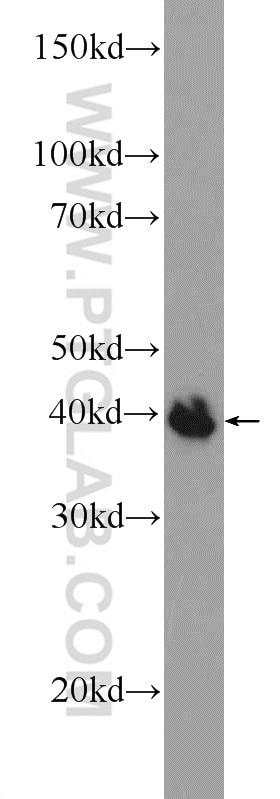POU3F4 Polyclonal antibody
POU3F4 Polyclonal Antibody for WB, ELISA
Host / Isotype
Rabbit / IgG
Reactivity
human, mouse
Applications
WB, IF, ELISA
Conjugate
Unconjugated
Cat no : 25114-1-AP
Synonyms
Validation Data Gallery
Tested Applications
| Positive WB detected in | fetal human brain tissue |
Recommended dilution
| Application | Dilution |
|---|---|
| Western Blot (WB) | WB : 1:200-1:1000 |
| It is recommended that this reagent should be titrated in each testing system to obtain optimal results. | |
| Sample-dependent, Check data in validation data gallery. | |
Published Applications
| IF | See 1 publications below |
Product Information
The immunogen of 25114-1-AP is POU3F4 Fusion Protein expressed in E. coli.
| Tested Reactivity | human, mouse |
| Cited Reactivity | mouse |
| Host / Isotype | Rabbit / IgG |
| Class | Polyclonal |
| Type | Antibody |
| Immunogen | POU3F4 fusion protein Ag18925 |
| Full Name | POU class 3 homeobox 4 |
| Calculated Molecular Weight | 361 aa, 39 kDa |
| Observed Molecular Weight | 40-45 kDa |
| GenBank Accession Number | BC146551 |
| Gene Symbol | POU3F4 |
| Gene ID (NCBI) | 5456 |
| RRID | AB_2879903 |
| Conjugate | Unconjugated |
| Form | Liquid |
| Purification Method | Antigen affinity purification |
| Storage Buffer | PBS with 0.02% sodium azide and 50% glycerol pH 7.3. |
| Storage Conditions | Store at -20°C. Stable for one year after shipment. Aliquoting is unnecessary for -20oC storage. 20ul sizes contain 0.1% BSA. |
Background Information
OTF9 also named as BRN4 and POU3F4, belongs to the POU transcription factor family and Class-3 subfamily. OTF9 is a transcription factor which exerts its primary action widely during early neural development and in a very limited set of neurons in the mature brain. Mutation of OTF9 will cause of X-linked deafness type 3 (DFN3).
Protocols
| Product Specific Protocols | |
|---|---|
| WB protocol for POU3F4 antibody 25114-1-AP | Download protocol |
| Standard Protocols | |
|---|---|
| Click here to view our Standard Protocols |
Publications
| Species | Application | Title |
|---|---|---|
J Biol Eng An engineered ligand-responsive Csy4 endoribonuclease controls transgene expression from Sendai virus vectors |


